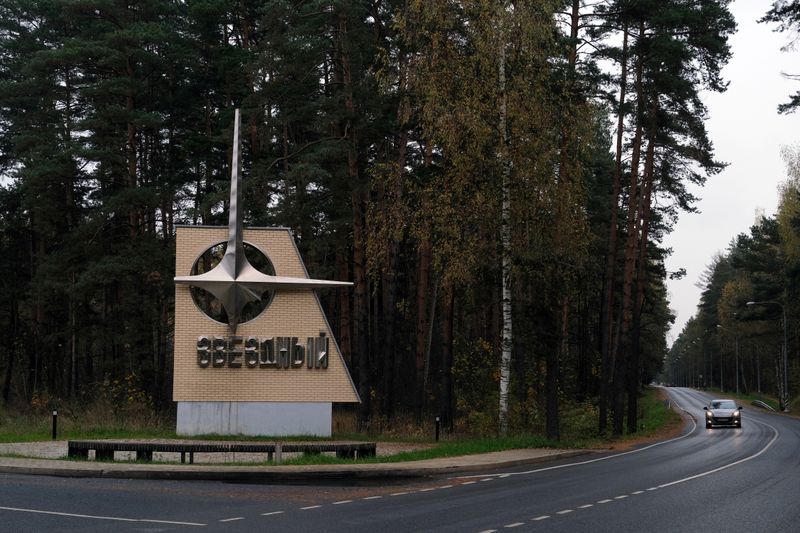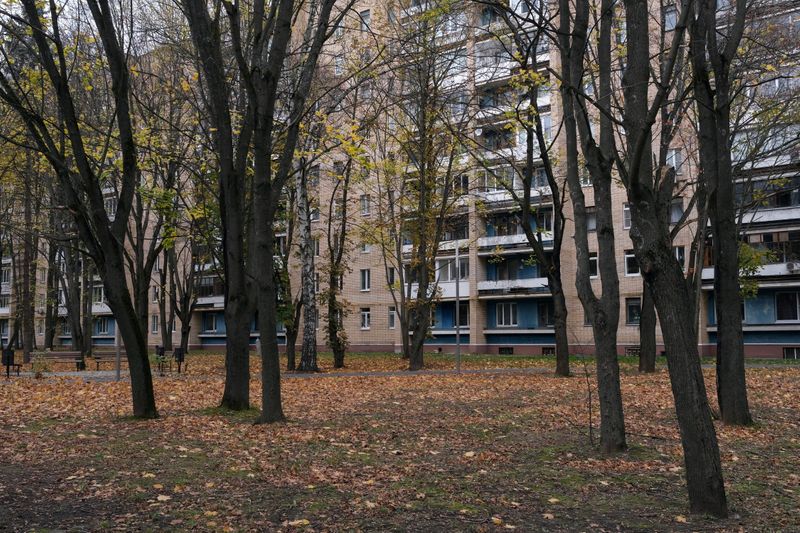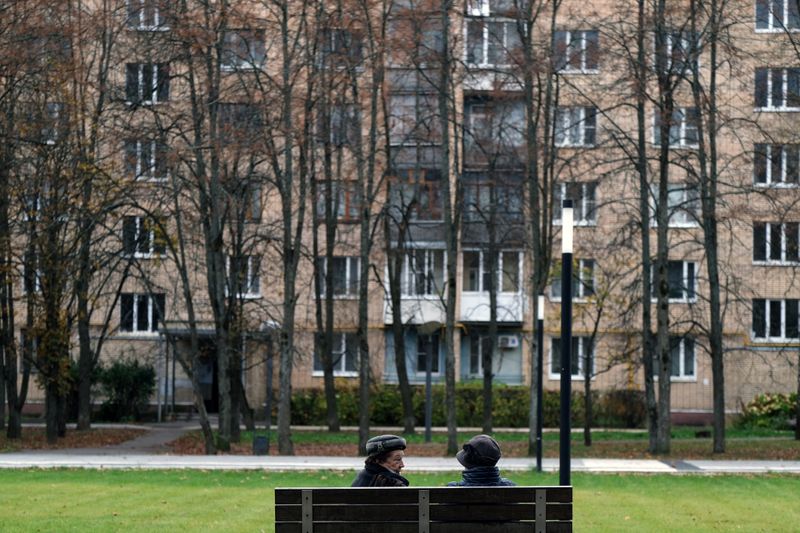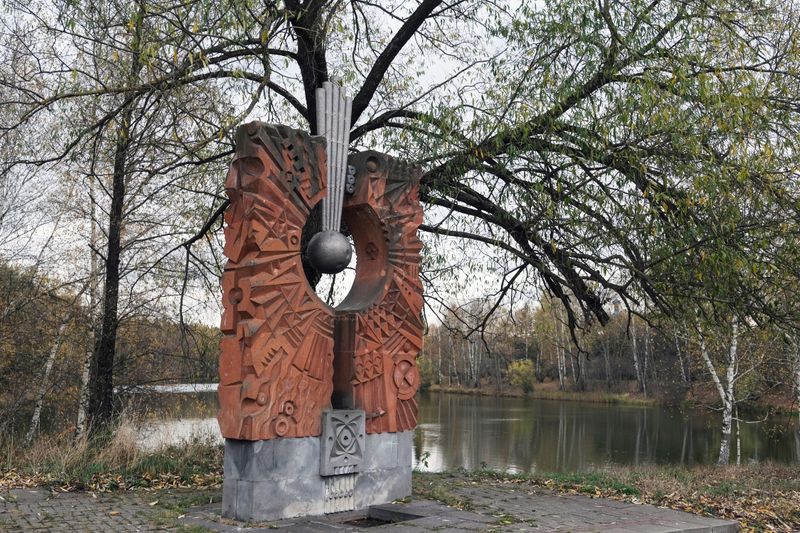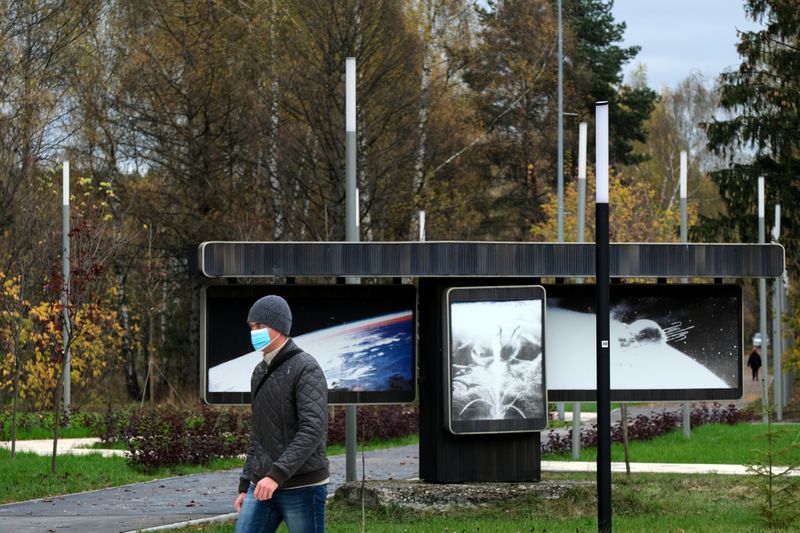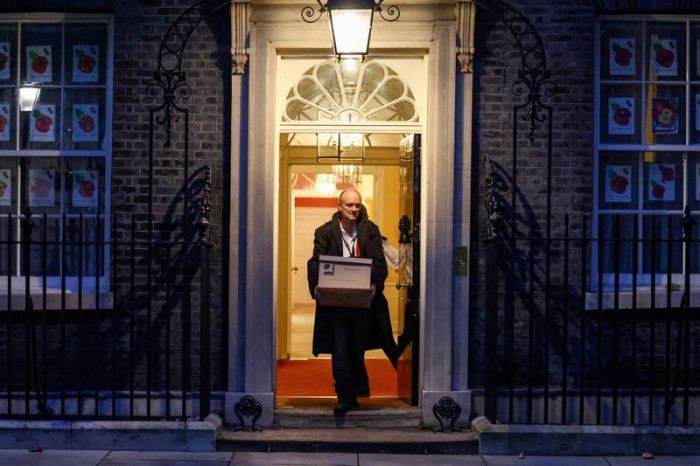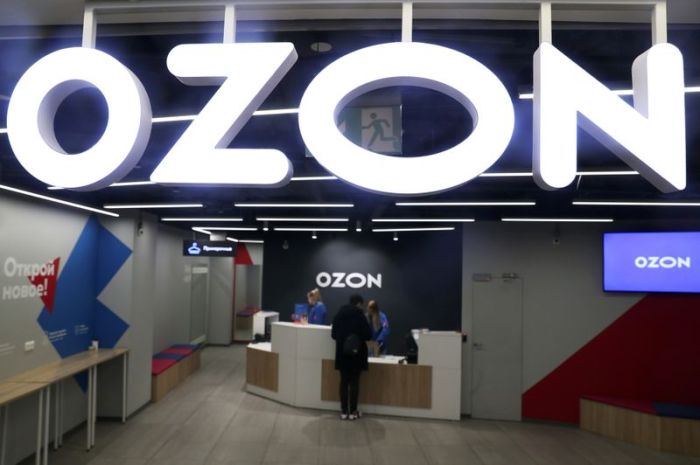STAR CITY, Russia (Reuters) – The Star City Closed Administrative Territorial Unit is barely an hour’s drive northeast of the Kremlin, but for decades the town never appeared on any maps. Only after the Soviet Union fell apart was its location revealed.
Even now, it is shrouded by forests, and behind its tall concrete walls lies the somber infrastructure of Russia’s legendary space program, and the Soviet-era apartment blocks that its cosmonauts and scientists call home.
Star City’s medical clinic stands in a wooded area just past a monument to Yuri Gagarin, who became the first man in space in 1961, and a soaring symbol of Cold War-era glory. To this day, flowers are often placed at his feet.
For around a decade, physician Natalya Lebedeva worked out of the Star City clinic as a paramedic. One autumn, she and another doctor were called out to the 12th-floor apartment of a young musician.
“We walk in and he’s in nothing but his underwear,” the other paramedic recalled. “And Natalya screams, ‘Grab him!'”
The young man was heading for the open window.
“If she hadn’t screamed, I wouldn’t have noticed. It didn’t even cross my mind that he might try to jump,” the paramedic said.
They wrestled the young man away from the ledge. “It’s good that he was wearing underwear, at least. Otherwise, I don’t know what I might have grabbed.”
Bleak tales peppered with black humor were part of everyday life for Lebedeva and her team as they navigated Russia’s often maddeningly bureaucratic and underfunded medical system.
So was the pressure, working in a close-knit and closed-off town, a place of rumor and recrimination, heroism and national pride.
“Star City is not just some city. The residents there are not easy,” said Irina Antropova, who worked with Lebedeva on the town’s ambulance service from 2006 until 2009. Fewer than 6,000 people live in the town’s dozen or so apartment blocks, many of them working for the Yuri Gagarin Cosmonaut Training Center. “They are cosmonauts, the families of cosmonauts, military personnel.”
In the circular building housing the training center’s centrifuge, a 300-ton arm spins cosmonauts around an 18-meter radius until the force of gravity acting on their bodies is multiplied up to eight times, replicating the feeling of re-entering the atmosphere, of falling to Earth.
A NEW DISEASE
When the first whispers of a new disease in China reached Russia in January, Lebedeva, a doctor trained in neurology, was working as the head of Star City’s ambulance service.
The team was close, ambulance driver Vladimir Chizhenko said. “We all lived as one collective.”
But medical work in Star City wasn’t standard fare. The clinic’s head doctor, Olga Minina, once received a late-night call on her mobile phone from a worried father asking about the health of his child. The father was cosmonaut Oleg Artemyev, and he was calling from space.
The town’s status, and the fame of its residents, ramped up the stress. Rumors spread fast in the insular town. “As it is a closed city, and outsiders do not have access to the territory, they all live there, stewing in this world of theirs,” Antropova said.
Lebedeva, 51, wasn’t married and lived alone. Private and independent by nature, friends said, she responded to the panopticоn in which she lived by keeping to herself.
“Of course, everyone was interested in her personal life,” Antropova said. “So she kept it all very secret.”
Lebedeva had moved to the Moscow region from her hometown in southern Russia after her mother died, and she began working as a Star City doctor in the 2000s.
In 2009, the town stopped being a military base. But its clinic, though now fully civilian, didn’t join the standard Russian healthcare system. Instead, in 2010 it entered the structure of the Federal Medical and Biological Agency (FMBA), a sparse network of medical facilities servicing Russia’s nuclear facilities and security services, the high-level scientific research sector and aerospace.
Under the FMBA, with its direct reporting line to the Kremlin, Star City’s clinic was a highly strung place.
Lebedeva was a buffer, shielding her team of drivers and paramedics, defending them in disputes, four members of the team said, recalling fierce arguments with the head doctor over hours and pay.
“Then we would spend time ‘resuscitating’ her after those meetings,” said a medical worker who spoke on condition of anonymity.
Minina, the head doctor, said that she and Lebedeva were close, even in the tense atmosphere of Star City.
“The residents who are on my watch, each one of them is a celebrity,” Minina said. “So, of course I can be quite tough, because for me – one misstep and it’s the firing squad.”
Minina recalled occasions when she too would shield Lebedeva and the ambulance team from complaints. They’d leave work together, exhausted, she said, but Lebedeva would still suggest they get coffee together, or go visit the church across town.
“We may have had our differences,” Minina said. “But she was a person that I could call at 4 a.m. and she’d get the job done. I trusted her very much.”
Antropova, the ambulance leader’s former coworker, said Lebedeva would take all the stress in her stride, saying, “Well, yes, well, yes, it’s not easy, but Irina, I’ll survive it.”
But even before the pandemic hit, she seemed different, ambulance driver Chizhenko said. She’d stopped joining the team on their lunch breaks, going for a walk instead, he said.
“I would tell her, why are you putting up with this? Leave this job. With your qualifications, you can always find another job. And recently, she had started to agree with me.”
On February 28, Chizhenko, tired of battles over pay, worked his last shift before handing in his notice. Two days later, the first confirmed case of the novel coronavirus in Moscow was discovered.
PREPARING FOR SPACE
That day, March 1, NASA astronaut Chris Cassidy arrived in Star City to prepare, together with two Russian cosmonauts, for a six-month stint on the International Space Station.
As they trained, coronavirus cases in Russia crept up, and restrictions grew. “I hear the streets in Moscow are quiet and empty,” Cassidy told a specialist spaceflight magazine toward the end of the month. “Here in Star City, it’s kind of like this oasis in the woods.”
On March 23, the astronauts laid flowers by Gagarin’s statue, and the next day set off for Russia’s space launch facility in Kazakhstan. It would be Star City’s last public event before lockdowns began.
Within a week, the number of reported coronavirus cases in Russia had shot up four times to more than 1,500. Moscow and the surrounding region – including Star City – went into lockdown. Regulations were strict: Residents could leave their homes only to reach the nearest shop or pharmacy, or to walk pets within a 100-meter radius.
Hospitals and healthcare workers across Moscow began to prepare for a crisis.
“HE WARNED US”
Raisa Ketseleva, daughter of Star City ambulance driver Victor Ketselev, 59, said her father had planned to be on holiday in Belarus in April.
“When this whole pandemic started … Dad had a big meeting at work and they said that it would reach their facility, too,” she said. So he canceled his trip. “He said: ‘I’m not going to abandon my colleagues. I will stay and work.'”
Ketseleva said that at first, she didn’t understand how serious the pandemic was. Many friends simply didn’t believe the coronavirus was real. “They didn’t show us that sort of thing” on state TV. Her father, though, “understood that it was an illness that could end in death. He warned us.”
He also told her that despite his ambulance work, the only protective equipment he had was a basic face mask.
Lebedeva was keenly aware of the danger facing her team. “She was very anxious about her work, about her department, about us … and members of our families, because all this fell on her shoulders,” her deputy, senior paramedic Marina Izmaylova, recalled.
Lebedeva began to lobby for staff to have access to protective gear and coronavirus tests, former coworker Antropova said.
“They were not being tested at the start of April,” Antropova said Lebedeva told her at the time. “The head doctor was refusing to test them, because if anyone tested positive, they would have had to put everyone” on quarantine. And if that happened, Star City would be left without medical care.
Head doctor Minina, however, painted a different picture: She said she personally secured 200 test kits – hard to come by at the time – from a research institute in Moscow. But there were guidelines and systems in place, and it was too early to test staff when there were no confirmed cases in the town, she said.
Some protective gear, earmarked for pandemic response, had been provided by the FMBA, and the team had far better kit than in neighboring clinics. Still, Minina said, she searched hard for additional supplies, amid a “super deficit” of masks on the market. In a statement, the FMBA said Star City’s clinic was provided with sufficient PPE for visits to patients with suspected COVID-19 and that testing of staff began March 25.
On April 2, the problem of testing and protective equipment blew up into an argument in the Star City clinic, said a doctor at the clinic who spoke on condition of anonymity. “Everything started boiling there,” the doctor said.
THE VIRUS REACHES STAR CITY
On April 11, on the eve of Star City’s annual celebration of Gagarin’s liftoff into space, ambulance driver Ketselev developed a sore throat.
On April 13, his temperature began to rise, his daughter said.
On April 15, his colleagues from the Star City clinic showed up to do a coronavirus test. A top Gagarin Training Center official had just tested positive, and mass testing of clinic staff had begun.
The next day, Ketselev’s test came back positive, his daughter said.
By that point, his shift partner had developed a cough. The partner’s wife and child were coughing, too, Ketselev’s daughter said. The third ambulance driver, a young man who had replaced Chizhenko when he quit, also fell ill, Chizhenko said.
On April 18, with his temperature soaring, Ketselev called Lebedeva and told her he was in agony. She said he should go to hospital, and after a long night searching for bed space, Ketselev was taken away in an ambulance. His daughter spent the next morning frantically ringing hospitals in the area, trying to work out where he might be.
By April 22, 27 staff members of the Star City clinic had tested positive for coronavirus, a letter sent to the town’s mayor on that date showed. So had 10 of their family members. Head doctor Minina, too, was in the ICU, with damage to 75% of her lungs, she said.
In the letter, cardiologist Svetlana Zakharova, who had taken over from Minina, asked the mayor to press the Moscow region health ministry for support.” The organization of medical support for the population of the Star City Closed Administrative Territorial Unit has become exceptionally difficult, especially the provision of emergency medical care,” according to the letter, seen by Reuters.
“At that point … we were truly fighting for our lives,” said senior paramedic Izmaylova, who was also hospitalized with severe COVID symptoms.
On April 20, Lebedeva was hospitalized in Moscow after testing positive.
BEFORE LIFTOFF, A CLOSE ENCOUNTER
In the days before the virus started to spread in Star City, the three astronauts were preparing for liftoff at the Russian cosmodrome in Baikonur.
On the morning of April 9, liftoff day, the three men, dressed in their white spacesuits, met with Dmitry Rogozin, head of the Russian space agency. They also met with Evgeny Mikrin, deputy head of RSC Energia, which had built the Soyuz rocket they were about to take.
The astronauts spoke with the officials through a wall of glass, a quarantine measure. They walked out to the launchpad without the traditional crowds of well-wishers lining their way. At 11:05 a.m. Moscow time, they blasted into space.
Two days after returning from the liftoff, rocket designer Mikrin, 64, started to feel unwell. A coronavirus test came back positive.
On April 12, Andrey Voloshin, a pilot and Gagarin Training Center official, also tested positive, a test results message seen by Reuters showed, becoming Star City’s first confirmed case. He had not attended the liftoff, but had met the party returning from Baikonur, Star City Mayor Evgeny Barishevsky said.
By the end of the month, 10 employees of the Gagarin Training Center had tested positive, local authorities reported. The space agency said 173 employees of Russia’s overall aerospace industry were sick, and six had died.
Mikrin would die of the disease on May 5. President Vladimir Putin wrote a short statement expressing his condolences online.
A spokesman for the Russian space agency, Roscosmos, said that the liftoff group had tested negative immediately before and after the trip to Baikonur. Although tests were known to be unreliable in those early days, he said, there was no concern because strict quarantine measures had been followed throughout the liftoff.
Still, within weeks of Russia’s first confirmed case, the coronavirus had penetrated the closed walls of Star City and crossed the high-security gates of its cosmonaut training center. It had radiated across Russia’s revered space program during a moment of international attention and national pride, and had, potentially, come within an inch of glass away from traveling to space in a cosmonaut.
THE SEARCH FOR SOMEONE TO BLAME
In Star City, with the clinic in the grip of the outbreak, a hunt was launched for someone to blame, the doctor at the clinic said.
“They wanted to blame us, that it was us that infected them, not the other way around,” the doctor said of officials with the space program. “They wanted to blame the doctors.
“And then they started coming down hard on [Lebedeva], claiming she fell ill, infected everyone,” the doctor said.
Head doctor Minina said she didn’t know of any probe into the outbreak at the time; she herself was already in the hospital. But she said that reports had spread widely around the town blaming Lebedeva for rocket designer Mikrin’s positive test – despite the fact that he wasn’t a resident, and the two had had no contact at all. But the rumor was there.
A Roscosmos spokesman said he recalled some talk of accusations of negligence at the time, but it did not come from the space agency. “We did not initiate [any investigation] … nor add to any rumors,” he said. That wouldn’t even be within the agency’s purview, he said.
According to the Gagarin Training Center, responding to a request for comment, the center had no issues with the Star City clinic’s work at all.
Lebedeva phoned several colleagues and close friends from her hospital bed, four people said. She had been admitted to the central FMBA hospital #83 in Moscow.
Her illness wasn’t severe. “Her temperature was a little over 37 degrees,” or 98.6 Fahrenheit, and “her lungs were affected only to a small degree,” her friend Antropova said.
During several calls from the ward, Lebedeva repeatedly said that she was being blamed for being the source of the outbreak, a friend said. “She called me and said … ‘I am going to be jailed. It’s the end for me.'”
“I said … ‘How were you supposed to have prevented this, how? How? Come on. What are you, God?'” the friend recalled.
But Lebedeva was in tears. She said she had been contacted by investigators from the police.
Ketseleva, the ambulance driver’s daughter, said that some weeks later, Star City police officer Maxim Statsenko visited her at home. He refused to disclose what he was investigating, she said. “But I asked him questions, of course, and I understood that they were searching for who fell sick first.”
Reuters called Officer Statsenko to ask him about Lebedeva and his investigation. “I don’t know anything,” he said, and hung up.
In a statement, the FMBA said: “The detection of COVID-19 among the employees of [the Star City clinic] led to an internal audit by the management of the FMBA’s interregional directorate #170. No charges were brought against N.V. Lebedeva as a result of the audit. The management of the FMBA and the [Star City clinic] also had no issues with the work of N.V. Lebedeva.”
Star City doctors criticized the idea of blaming anyone at all during a pandemic or searching for who infected whom. “We did everything by the book,” head doctor Minina said. “I’m a doctor, not a ballerina. I got sick because I was on the front line.”
On April 23, ambulance driver Ketselev was hooked up to a ventilator. Chances of recovery for patients on a ventilator were known to be low.
From her hospital bed, Lebedeva wrote a WhatsApp message to Minina: “I have understood that this is the virus of panic and fear.”
A FALL TO EARTH
Lebedeva was last active on WhatsApp at 00:21 on Friday, April 24, said a friend and former colleague at the Star City clinic, Natalya Zhernakova.
That day, several friends couldn’t reach her by phone. They began calling the FMBA hospital, friend Antropova recalled, but “the hospital told them that all information about Lebedeva was ‘closed.'”
On Saturday, Lebedeva’s friends contacted the Star City clinic ambulance service, Antropova said. “And her colleagues already… They had already received the information,” Antropova said, her voice breaking.
“They had been told that Natalya … had committed suicide.”
She had fallen from the window of the Moscow hospital’s coronavirus ward and died from her injuries, a television channel reported.
The FMBA released a statement on April 27: “On April 24, 2020, as the result of an unfortunate accident, Natalya Lebedeva tragically died.”
The word “accident” angered many of Lebedeva’s friends, who believe she committed suicide out of desperation.
Responding to a request for comment, the FMBA said her death was a tragic event and that law enforcement officials have opened an investigation.
With no confirmation of the manner of Lebedeva’s death from the FMBA, the town stewed.
“They’ll cover it all up, because it’s space. Serious people are involved,” the doctor at the clinic said. “That’s why they wanted to blame it all on the ambulance service.”
A week after Lebedeva’s death, Ketseleva was told that her father, the ambulance driver, had died. Her mother was left to grieve alone and in quarantine for another month.
Ketseleva was sent a video, seen by Reuters. The person recording it walks through the empty corridors of Star City’s clinic. Benches are cordoned off with red-and-white hazard tape. At reception, the camera turns a corner.
There, under a bouquet of flowers, stand portraits of Ketselev and Lebedeva, a black ribbon on each.
SWAN SONG
In early May, a funeral cortege traveled slowly through Star City, followed by two ambulances with sirens on throughout. The coffin for Lebedeva, whose surname is derived from the Russian word for swan, lebed, was white.
Star City resident Dmitry Saraev and others wrote on social media of watching from their windows. “This mourning escort became Natasha’s swan song, performed not by her but by her staff and vehicles,” Saraev wrote.
Star City ambulance dispatcher Tatyana Krivushina, 65, fell sick soon after her mother, who died in late May. Krivushina died on June 6.
In the last days of August, the head of the FMBA, Veronika Skvortsova, visited Star City. Pulling up in a black Mercedes, she toured the Gagarin Training Center, posing for a photograph in front of а Soyuz rocket training simulator.
Skvortsova also toured the Star City clinic. Among her festive welcome party was Valentina Tereshkova, the first woman in space.
Skvortsova talked to doctors and inspected the clinic’s equipment, an official video showed. In the 2.5-minute clip, the outbreak at the clinic wasn’t mentioned.
At one point on her tour, Skvortsova visited the clinic’s reception area. A press photo shows her standing in the corner by a noticeboard.
Behind her is the table on which the memorial bouquet was placed next to the framed photographs of Ketselev and Lebedeva. By the time of the official visit, the flowers and the portraits were gone.
(This story refiles to fix dropped word in headline and garble in 15th paragraph)
(Reporting by Polina Ivanova; editing by Kari Howard)

